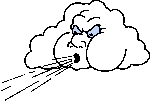|
Force | MPH | Description | Visible Condition
|
| 0 |
0 | Calm | Smoke rises vertically
|
| 1 | 1 - 4 | Light | Air direction of wind shown by smoke but not by wind vanes
|
| 2 | 4 - 7 | Light breeze | Wind felt on face; leaves rustle; ordinary wind vane
moved by wind
|
| 3 | 8 - 12 | Gentle breeze | Leaves and small twigs in constant motion; wind
extends light flag
|
| 4 | 13 - 18 | Moderate breeze | Raises dust and loose paper; small branches are
moved
|
| 5 | 19 - 24 | Fresh breeze | Small trees in leaf begin to sway; crested wavelets
form on inland water
Wright Brother's first flight
|
| 6 | 25 - 31 | Strong breeze | Large branches in motion; telephone wires whistle;
umbrellas used with difficulty
|
| 7 | 32 - 38 | Moderate gale | Whole trees in motion; inconvenience in walking
against wind
|
| 8 | 39 - 46 | Fresh gale | Breaks twigs off trees; generally impedes progress
|
| 9 | 47 - 54 | Strong gale | Slight structural damage occurs; chimney pots and
slates removed
Airplanes upset
|
| 10 | 55 - 63 | Whole gale | Trees uprooted; considerable structural damage occurs
|
| 11 | 64 - 72 | Storm | Very rarely experienced; accompanied by widespread damage
|
| 12 | 73+ | Hurricane | Devastation occurs
|









